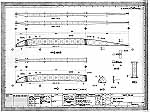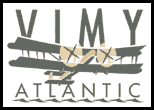Building the Vimy:
Part I: In the Beginning
by Miles McCallum
The genesis of the Vimy replica started when Peter McMillan,
a young investment broker from San Francisco, entered
the 1990 England to Australia Vintage air rally. Organised
by Lang Kidby, an ex-Australian Army air corps pilot (with
an RAF instructor rating), he was talking to Peter after
he had "won" the rally in his Harvard.
"Wouldn't it be nice," mused Lang, "to do the flight
again in a really historic aeroplane like the Vimy flown
by Ross and Keith Smith in 1919..."
This caught Peter's imagination: "I wanted to build a
time machine and experience the world as a larger place,
while reminding others of the debt we owe to the forgotten
pioneers of the air who deserve a place alongside Magellan,
Columbus and Captain Cook. They inspired the world to
the possibilities of air travel, and should remind us
that risks will always be involved in transforming dreams
to real progress."
 The
first step was to obtain a set of original drawings for
the Vimy, so a worldwide search was started. That came
up trumps in January '93 when Bill Whitney of Aeronautical
Designs Australia produced a full set on microfilm. He
was commissioned to design the required stress analysis
for a replica using modern materials and powerplants. The
first step was to obtain a set of original drawings for
the Vimy, so a worldwide search was started. That came
up trumps in January '93 when Bill Whitney of Aeronautical
Designs Australia produced a full set on microfilm. He
was commissioned to design the required stress analysis
for a replica using modern materials and powerplants.
In effect, the Vimy replica is a new aeroplane, the world's
largest (and almost certainly the most expensive) homebuilt.
The fuselage is made from 4130 steel tube instead of a
wire braced wood truss, and is powered by a pair of
geared-down Chevrolet big block V8s of 454cu in (7.4 litres)
apiece. The wings and tail are much as designed by Vickers
during WW1. What wasn't changed, of course, was the external
shape; in fact, extreme pains were taken to make it as
authentic as possible.
By March '93, the basic design was finalised and construction
began on the tail and PRSUs (propeller speed reduction
units), in Australia. By May, the wing design was completed,
and a 15,000sq ft building obtained in Sonoma, California.
A crew was assembled from the Scenic Artists Guild - craftsmen
and women who usually build sets for the movie industry.
© Miles McCallum 1997, 1998
| 

